Pesticide Use Practices in Root, Tuber, and Banana Crops by Smallholder Farmers in Rwanda and Burundi
Abstract
1. Introduction
2. Materials and Methods
2.1. Survey Area and Tool
2.2. Ethical Statement
2.3. Statistical Analysis
3. Results
3.1. Pest and Disease Management Practices
3.2. Pesticides Used
3.2.1. Active Ingredients and Toxicity Classes
3.2.2. Pesticides Application Frequency
3.2.3. Use of Personal Protective Equipment (PPE) during Application
3.2.4. Regression Model Results on PPE Use
3.2.5. Symptoms after Pesticide Applications and Reported Consequences of Pesticide Poisoning
3.2.6. Various Pesticide Parameters
4. Discussion
4.1. Pesticide Active Ingredients and Toxicity Classes
4.2. Chemical Pesticides Application Frequency
4.3. Use of Personal Protective Equipment (PPE) during Application
4.4. Perception and Information about Pesticide Use
5. Conclusions
Supplementary Materials
Author Contributions
Funding
Acknowledgments
Conflicts of Interest
References
- Low, J.W.; Mwanga, R.O.; Andrade, M.; Carey, E.; Ball, A.-M. Tackling vitamin A deficiency with biofortified sweetpotato in sub-Saharan Africa. Glob. Food Secur. 2017, 14, 23–30. [Google Scholar] [CrossRef] [PubMed]
- Murray-Kolb, L.E.; Wenger, M.J.; Scott, S.P.; Rhoten, S.E.; Lung’aho, M.G.; Haas, J.D. Consumption of iron-biofortified beans positively affects cognitive performance in 18- to 27-year-old Rwandan female college students in an 18-week randomized controlled efficacy trial. J. Nutr. 2017, 147, 2109–2117. [Google Scholar] [CrossRef] [PubMed]
- Rukazambuga, D. The National Integrated Pest Management Framework For Rwanda; Rwanda Environment Management Authority: Kigali, Rwanda, 2008. [Google Scholar]
- Masengesho, J.; Nshimiyimana, J.; Senkesha, N.; Sallah, P. Performance of Irish potato varieties under aeroponic conditions in Rwanda. Rwanda J. 2012, 28, 84–94. [Google Scholar] [CrossRef]
- Muyinza, H.; Talwana, H.L.; Mwanga, R.O.M.; Stevenson, P.C. Sweetpotato weevil (Cylas spp.) resistance in African sweetpotato germplasm. Int. J. Pest Manag. 2012, 58, 73–81. [Google Scholar]
- Karamura, E.; Osiru, M.O.; Blomme, G.; Lusty, C.; Picq, C. Developing a Regional Strategy to Address the Outbreak of Banana Xanthomonas wilt in East and Central Africa; Bioversity International: Rome, Italy, 2006. [Google Scholar]
- Ghislain, M.; Byarugaba, A.A.; Magembe, E.; Njoroge, A.; Rivera, C.; Román, M.L.; Tovar, J.C.; Gamboa, S.; Forbes, G.A.; Kreuze, J.F.; et al. Stacking three late blight resistance genes from wild species directly into African highland potato varieties confers complete field resistance to local blight races. Plant Biotechnol. J. 2018. [Google Scholar] [CrossRef] [PubMed]
- Okonya, J.S.; Kroschel, J. Farmers’ knowledge and perceptions of potato pests and their management in Uganda. J. Agric. Rural Dev. Trop. Subtrop. 2016, 117, 87–97. [Google Scholar]
- World Health Organization. Chemicals of Public Health Concern in the African Region and Their Management: Regional Assessment Report; World Health Organization: Geneva, Switzerland, 2015. [Google Scholar]
- NISR. Seasonal Agricultural Survey 2014; National Institute of Statistics of Rwanda Kigali: Kigali, Rwanda, 2015.
- Umubyeyi, S.; Rukazambuga, N. Small scale farmers’ knowledge on grain losses from bean bruchid, pesticides safe use and implication on food security and safety in Huye District, Rwanda. Rwanda J. 2016, 1. [Google Scholar] [CrossRef]
- Mutshail, G.; Yamuremye, A.; Niyongere, C.; Mbonihankuye, C. Utilization of pesticides in smallholder horticulture production pinpoint the need for cropping system changes in Burundi. In Proceedings of the XXIX International Horticultural Congress on Horticulture: Sustaining Lives, Livelihoods and Landscapes (IHC2014), Brisbane, Australia, 17–22 August 2014; pp. 213–220. [Google Scholar]
- Orozco, F.A.; Cole, D.C.; Forbes, G.; Kroschel, J.; Wanigaratne, S.; Arica, D. Monitoring adherence to the international code of conduct: Highly hazardous pesticides in central Andean agriculture and farmers’ rights to health. Int. J. Occup. Environ. Health 2009, 15, 255–268. [Google Scholar] [CrossRef]
- Kim, K.-H.; Kabir, E.; Jahan, S.A. Exposure to pesticides and the associated human health effects. Sci. Total Environ. 2017, 575, 525–535. [Google Scholar] [CrossRef]
- Chang, Q.; Wang, W.; Regev-Yochay, G.; Lipsitch, M.; Hanage, W.P. Antibiotics in agriculture and the risk to human health: How worried should we be? Evol. Appl. 2015, 8, 240–247. [Google Scholar] [CrossRef]
- Guyton, K.Z.; Loomis, D.; Grosse, Y.; El Ghissassi, F.; Benbrahim-Tallaa, L.; Guha, N.; Scoccianti, C.; Mattock, H.; Straif, K. Carcinogenicity of tetrachlorvinphos, parathion, malathion, diazinon, and glyphosate. Lancet Oncol. 2015, 16, 490–491. [Google Scholar] [CrossRef]
- Kroschel, J.; Okonya, J.S.; Juarez, H.; Forbes, G.; Kreuze, J.; Beed, F.; Blomme, G.; Legg, J. Project Planning Workshop; CGIAR Research Program on Roots, Tubers and Bananas (RTB): Montpellier, France, 2014. [Google Scholar]
- Polder, A.; Müller, M.; Lyche, J.; Mdegela, R.; Nonga, H.; Mabiki, F.; Mbise, T.; Skaare, J.; Sandvik, M.; Skjerve, E. Levels and patterns of persistent organic pollutants (POPs) in tilapia (Oreochromis sp.) from four different lakes in Tanzania: Geographical differences and implications for human health. Sci. Total Environ. 2014, 488, 252–260. [Google Scholar] [CrossRef] [PubMed]
- Walker, L.; Wu, S. Pollinators and Pesticides. In International Farm Animal, Wildlife and Food Safety Law; Springer: Berlin, Germany, 2017; pp. 495–513. [Google Scholar]
- Houbraken, M.; Habimana, V.; Senaeve, D.; López-Dávila, E.; Spanoghe, P. Multi-residue determination and ecological risk assessment of pesticides in the lakes of Rwanda. Sci. Total Environ. 2017, 576, 888–894. [Google Scholar] [CrossRef] [PubMed]
- Mew, E.J.; Padmanathan, P.; Konradsen, F.; Eddleston, M.; Chang, S.-S.; Phillips, M.R.; Gunnell, D. The global burden of fatal self-poisoning with pesticides 2006-15: Systematic review. J. Affect. Disord. 2017, 219, 93–104. [Google Scholar] [CrossRef] [PubMed]
- Ntow, W.J. Organochlorine pesticides in water, sediment, crops, and human fluids in a farming community in Ghana. Arch. Environ. Contam. Toxicol. 2001, 40, 557–563. [Google Scholar] [CrossRef] [PubMed]
- Du, J.; Gridneva, Z.; Gay, M.C.; Trengove, R.D.; Hartmann, P.E.; Geddes, D.T. Pesticides in human milk of Western Australian women and their influence on infant growth outcomes: A cross-sectional study. Chemosphere 2017, 167, 247–254. [Google Scholar] [CrossRef]
- Müller, M.; Polder, A.; Brynildsrud, O.; Karimi, M.; Lie, E.; Manyilizu, W.; Mdegela, R.; Mokiti, F.; Murtadha, M.; Nonga, H. Organochlorine pesticides (OCPs) and polychlorinated biphenyls (PCBs) in human breast milk and associated health risks to nursing infants in Northern Tanzania. Environ. Res. 2017, 154, 425–434. [Google Scholar] [CrossRef]
- Donkor, A.; Osei-Fosu, P.; Dubey, B.; Kingsford-Adaboh, R.; Ziwu, C.; Asante, I. Pesticide residues in fruits and vegetables in Ghana: A review. Environ. Sci. Pollut. Res. 2016, 23, 18966–18987. [Google Scholar] [CrossRef]
- SAS Software, Version 9. SAS Institute Inc.: Cary, NC, USA, 2012.
- Lambert, D. Zero-inflated Poisson regression, with an application to defects in manufacturing. Technometrics 1992, 34, 1–14. [Google Scholar] [CrossRef]
- Cameron, A.C.; Trivedi, P.K. Microeconometrics: Methods and Applications; Cambridge University Press: Cambridge, UK, 2005. [Google Scholar]
- Perumean-Chaney, S.E.; Morgan, C.; McDowall, D.; Aban, I. Zero-inflated and overdispersed: What’s one to do? J. Stat. Comput. Simul. 2013, 83, 1671–1683. [Google Scholar] [CrossRef]
- Vuong, Q.H. Likelihood ratio tests for model selection and non-nested hypotheses. Econometrica 1989, 57, 307–333. [Google Scholar] [CrossRef]
- World Health Organization & International Programme on Chemical Safety (2010); World Health Organization. WHO Recommended Classification of Pesticides by Hazard and Guidelines to Classification 2009; World Health Organization: Geneva, Switzerland, 2010. [Google Scholar]
- Zawedde, B.M.; Kwehangana, M.; Oloka, H. Readiness for environmental release of genetically engineered (GE) plants in Uganda. Front. Bioeng. Biotechnol. 2018, 6, 152. [Google Scholar] [CrossRef] [PubMed]
- Nshimiyimana, J.C.; Ndirigwe, J.; Sindi, K.; Uwase, V.; McEwan, M.; Lowc, J. Delivering Clean Sweetpotato Vines in Rwand; CGIAR Research Program on Roots, Tubers and Bananas (RTB): Montpellier, France, 2016; p. 98. [Google Scholar]
- Blomme, G.; Ocimati, W.; Sivirihauma, C.; Vutseme, L.; Mariamu, B.; Kamira, M.; van Schagen, B.; Ekboir, J.; Ntamwira, J. A control package revolving around the removal of single diseased banana stems is effective for the restoration of Xanthomonas wilt infected fields. Eur. J. Plant Pathol. 2017, 149, 385–400. [Google Scholar]
- Legg, J.; Ndalahwa, M.; Yabeja, J.; Ndyetabula, I.; Bouwmeester, H.; Shirima, R.; Mtunda, K. Community phytosanitation to manage cassava brown streak disease. Virus Res. 2017, 241, 236–253. [Google Scholar] [CrossRef]
- Okonya, J.S.; Kroschel, J. A cross-sectional study of pesticide use and knowledge of smallholder potato farmers in Uganda. BioMed Res. Int. 2015, 2015, 759049. [Google Scholar] [CrossRef] [PubMed]
- Mengistie, B.T.; Mol, A.P.; Oosterveer, P. Pesticide use practices among smallholder vegetable farmers in Ethiopian Central Rift Valley. Environ. Dev. Sustain. 2017, 19, 301–324. [Google Scholar] [CrossRef]
- Glenn, D. Determining Sample Size, Document, Program Evaluation and Organizational Development; Institute of Food and Agricultural Sciences; University of Florida: Gainesville, FL, USA, 2013; Volume PEOD6, p. 3. [Google Scholar]
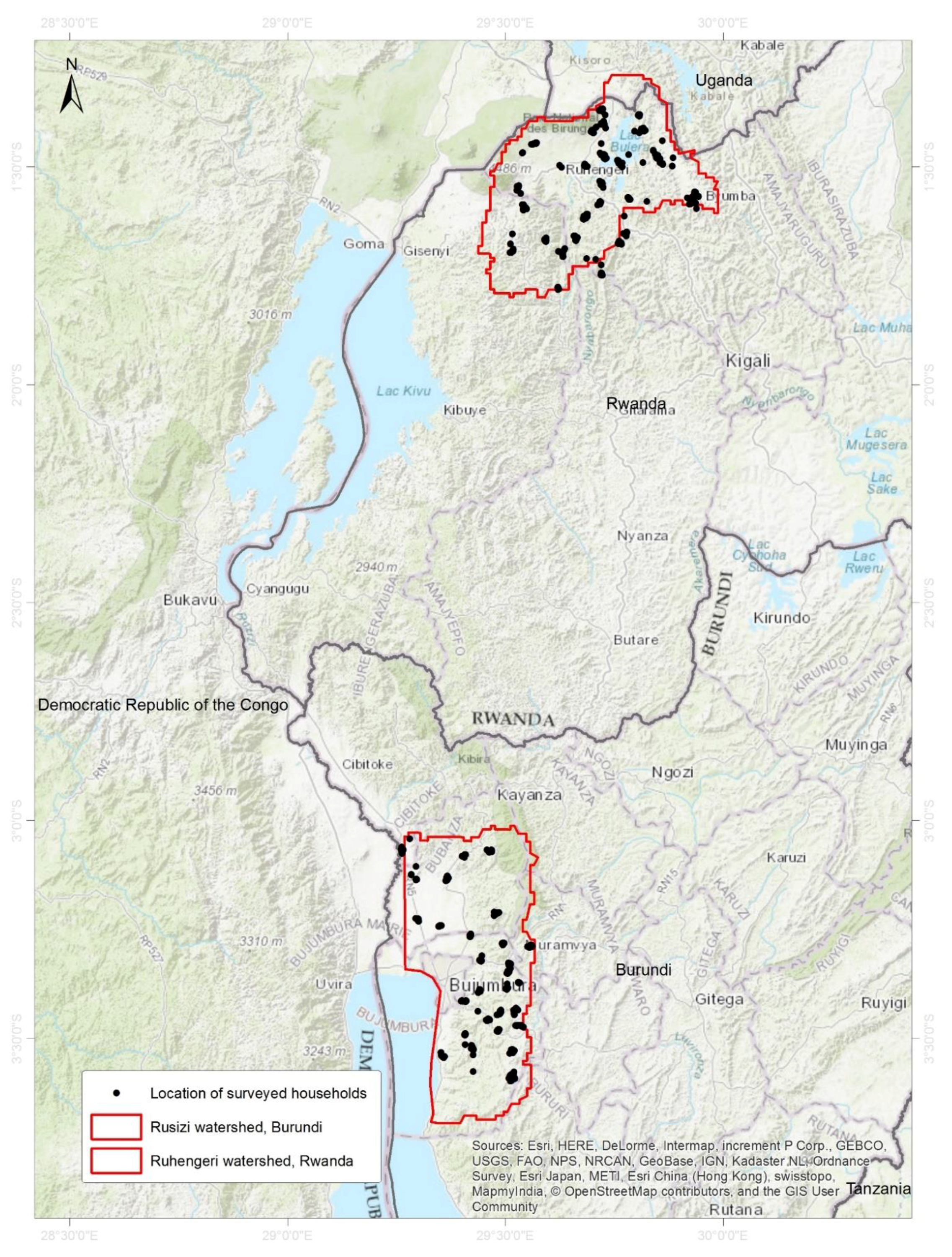
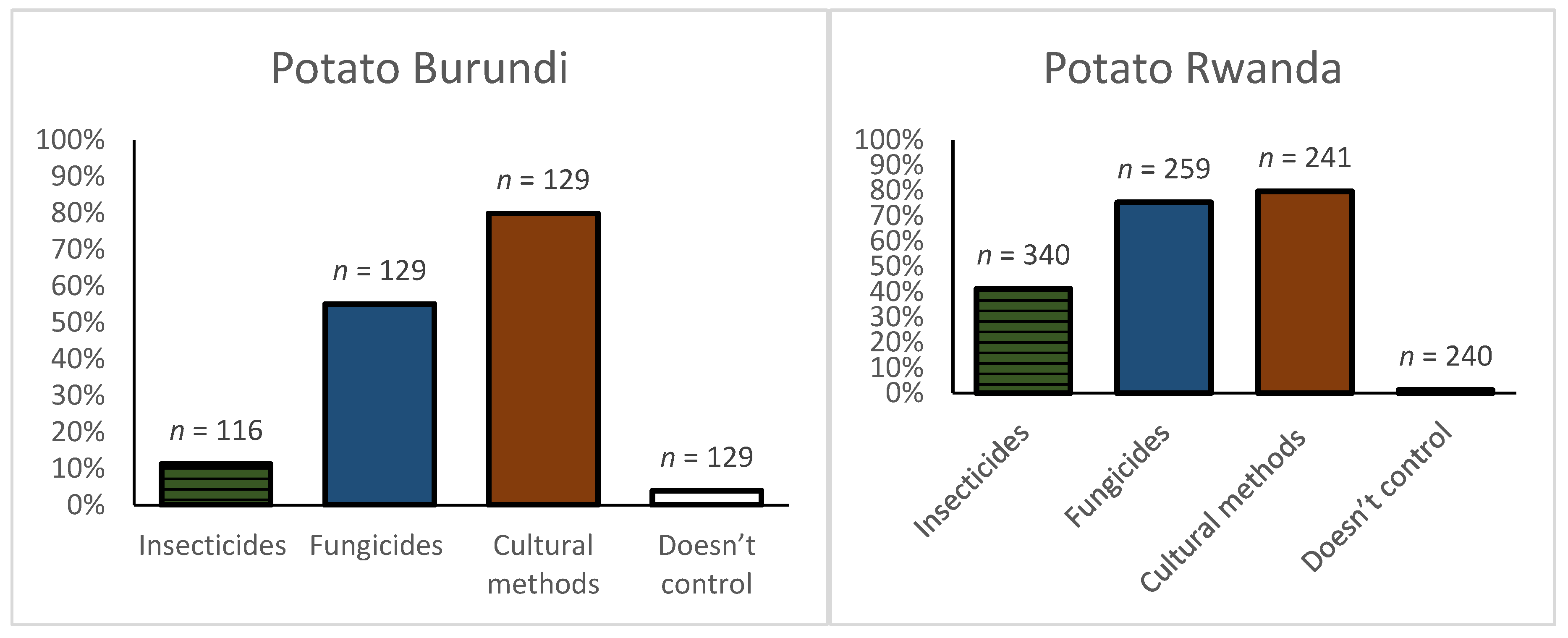
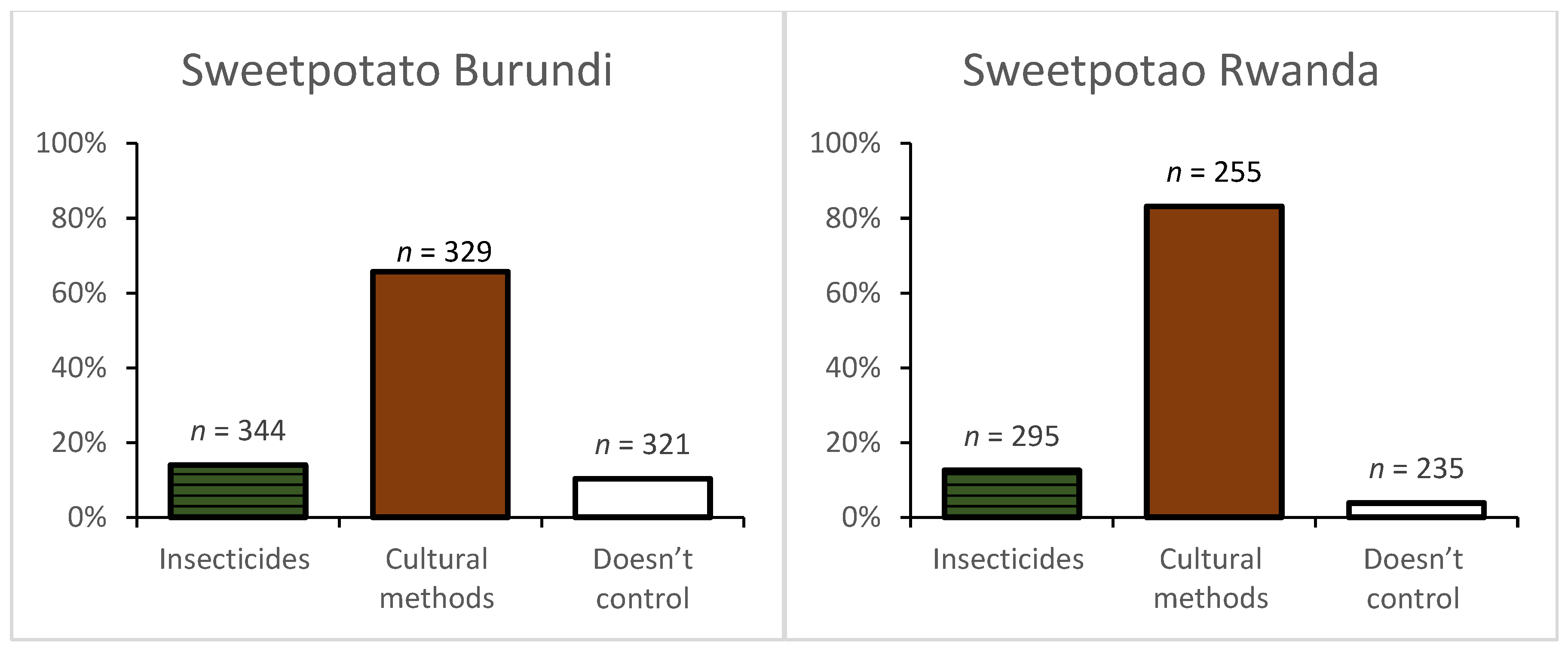
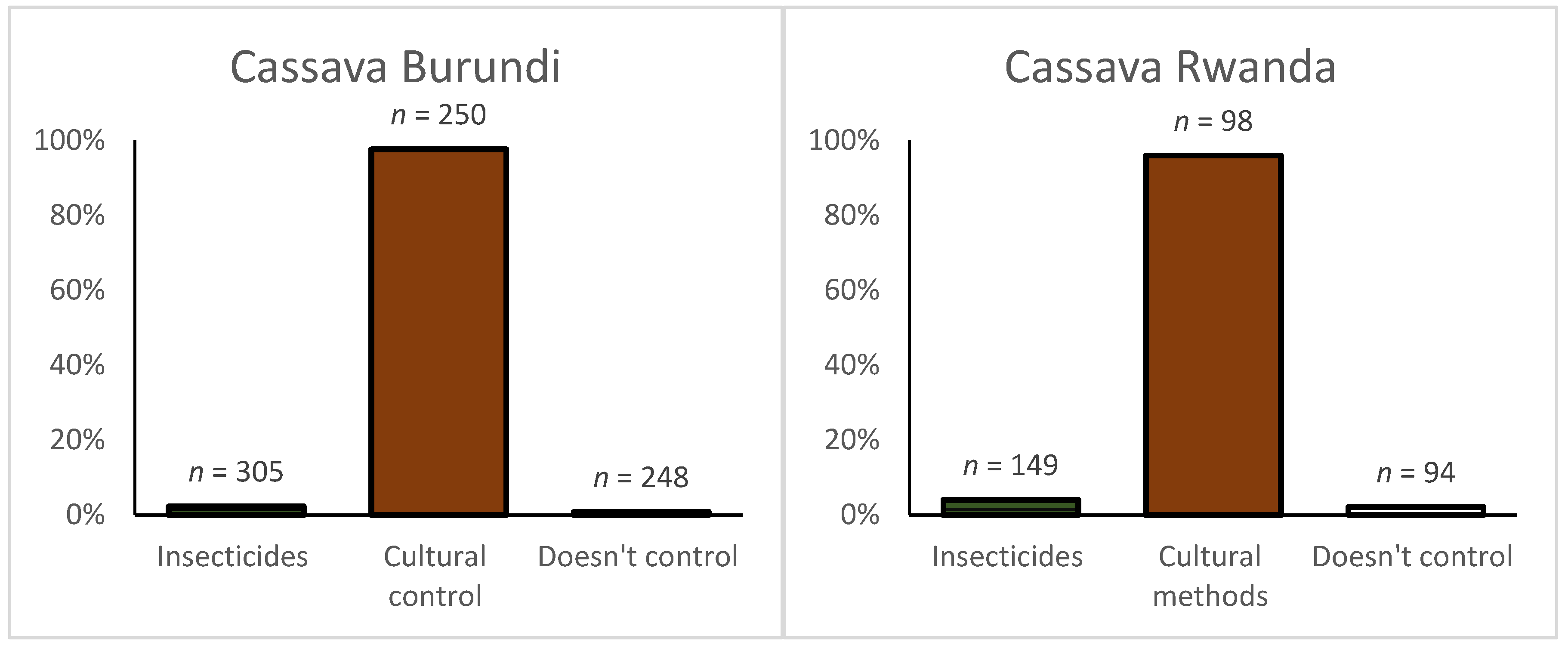
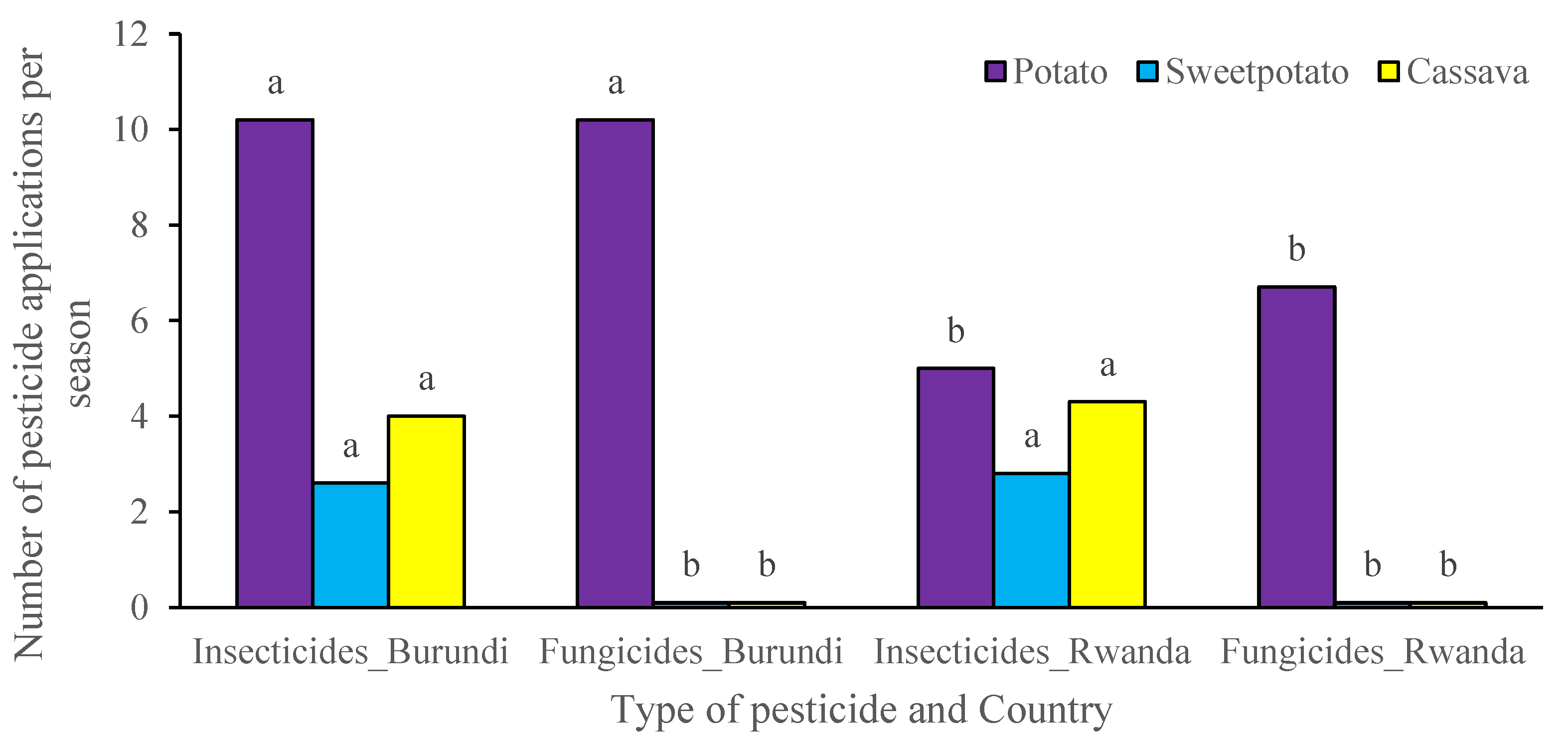
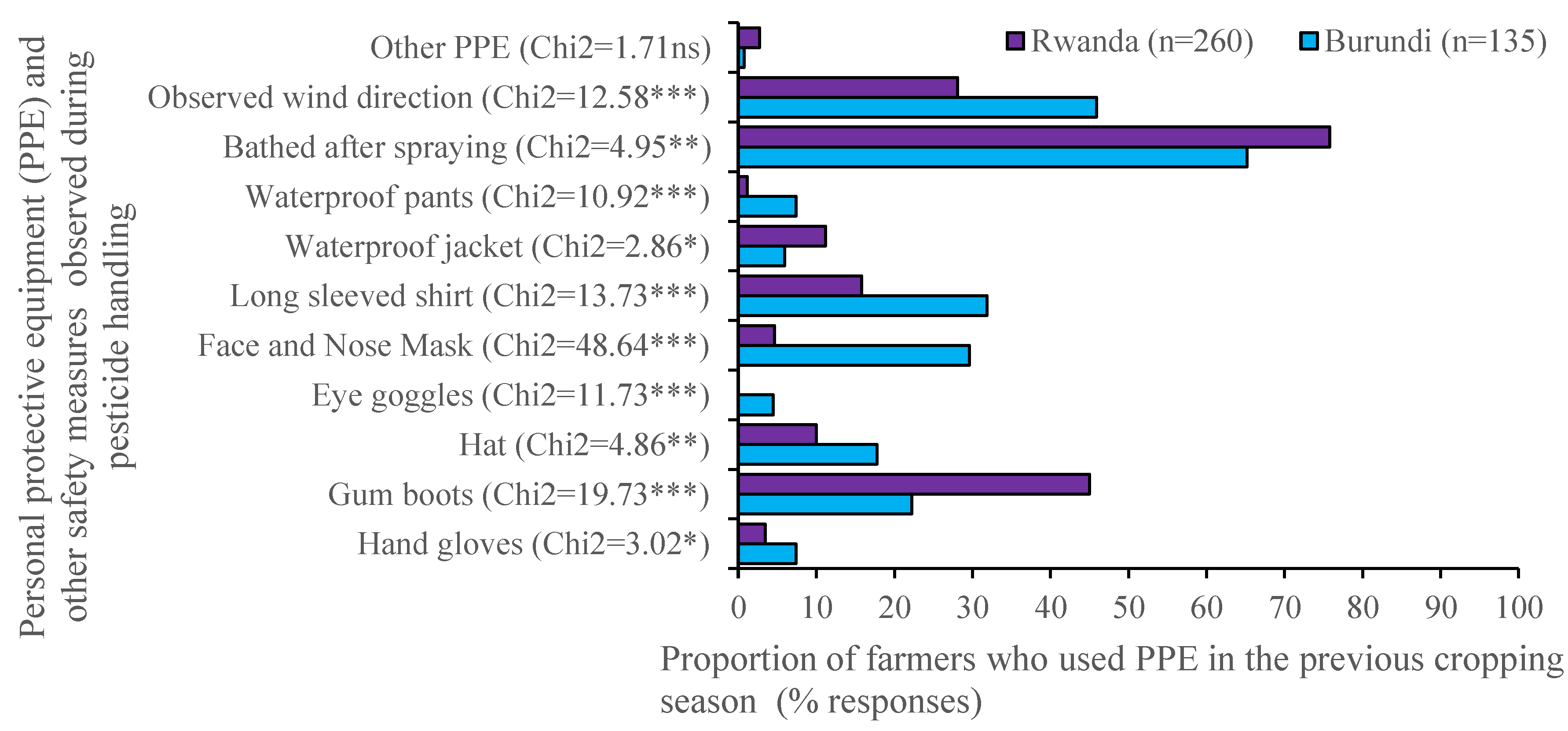
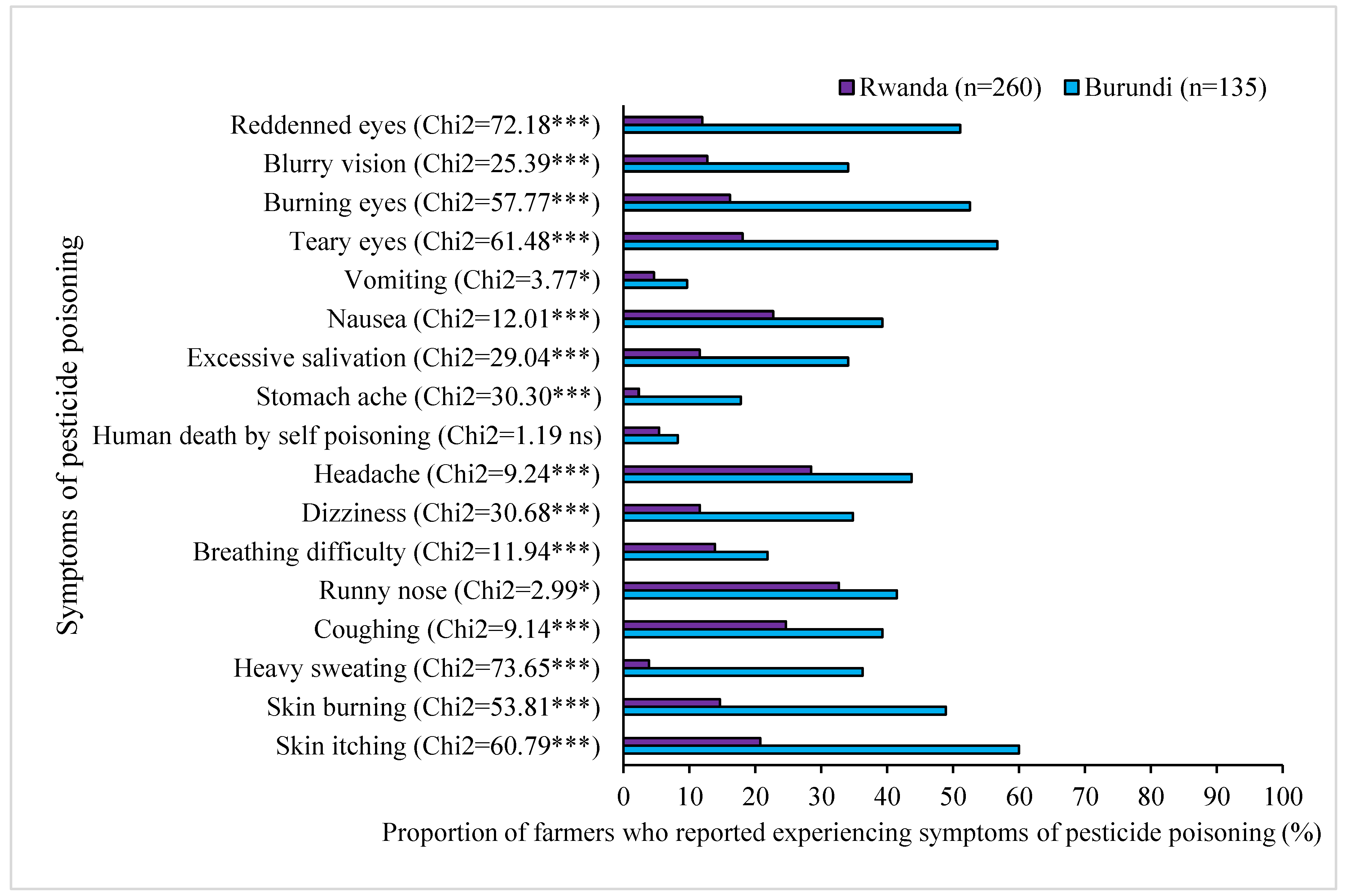
| No. | Trade Name | Active Ingredient | WHO Toxic Class (a) | Target Pest or Disease |
|---|---|---|---|---|
| Insecticides | ||||
| 1 | Dursban 48 EC | Chlorpyrifos 48% | II | Sweetpotato armyworm (Spodoptera spp.), sweetpotato butterfly (Acraea acerata Hew. and the sweetpotato whitefly (Bemisia tabaci Gennadius) in sweetpotato Cassava mealybug (Phenacoccus manihoti Matile-Ferrero), cassava whitefly (Bemisia tabaci Gennadius) in cassava Ants (Dorylis spp.), aphids (Aphis gossypii Glover, Aphis fabae Scopoli, Macrosiphum euphorbiae Thomas, and Myzus persicae Sulzer), cutworm (Agrotis spp.), leafminer fly (Liriomyza spp.) and whitefly (Bemisia tabaci) in potato |
| 2 | Rocket 44 EC | Cypermethrin 4% + Profenofos 40% | ||
| 3 | Cyper | cypermethrin 5% | ||
| 4 | CyperGreen | |||
| 5 | CyperLacer 5 EC | |||
| 6 | Cypermethrin | |||
| 7 | Dudu | |||
| 8 | Dudu Cyper | |||
| 9 | Dimethoate | Dimethoate 40% | ||
| 10 | Tafgor 40 EC | |||
| 11 | Malataf 57 EC | Malathion 57% | III | Potato tuber moth (Phthorimaea operculella (Zeller)) during seed potato storage |
| Fungicides | ||||
| 1 | Ridomil Gold | Mancozeb 64% + Metalaxyl 4% | II | Late blight in potato |
| 2 | Emexyl | Mancozeb 64% + Metalaxyl 8% | ||
| 3 | Victory 72 WP | |||
| 4 | Safari max | |||
| 5 | Safarizeb | Mancozeb 80% | U | |
| 6 | Dithane M 45 | |||
| 7 | Mancozeb 80 WP | |||
| 8 | Benlate | Benomyl |
| Variables | Mean | Std. | Min | Max |
|---|---|---|---|---|
| Dependent variable | ||||
| Number of personal protective equipment (PPE) | 0.9 | 1.4 | 0 | 8 |
| Independent variables (continuous) | ||||
| Application frequency per season (APP_FRQ) | 4.7 | 7.0 | 0 | 40 |
| Potato field size in the current cropping season in square meters (POT_FLD) | 2166.2 | 3063.2 | 0 | 16,200 |
| Years of applying pesticides in potato (YRS_PST) | 7.5 | 8.6 | 0 | 37 |
| Years of growing potato (YRS_POT) | 16.8 | 14.5 | 0 | 80 |
| Total Annual Income in US $ (INC_USD) | 706.8 | 1065.9 | 0 | 9863 |
| Age of the head of the household (AGE_HH) | 44.6 | 13.9 | 19 | 80 |
| Altitude of household location in meters (ALT) | 2194.4 | 175.3 | 1594 | 2574 |
| Independent variables (binary) | no | yes | ||
| Application of pesticides in potato storage (APP_STORE) | 287 | 39 | ||
| Someone of the family fell sick from using pesticides (FAM_EFF) | 294 | 32 | ||
| Have you experienced any effect after pesticide applications (OWN_EFF) | 159 | 167 | ||
| Member of HH involved in a farmer organization (HH_ORG) | 236 | 90 | ||
| Received training in pest and disease management of potato (MNG_EDU) | 272 | 54 | ||
| Independent variables (categorical) | ||||
| Country of origin (CTY) | Rwanda | 216 | ||
| Burundi | 110 | |||
| Formal education of the head of the HH (HH_EDU) | none | 87 | ||
| primary | 185 | |||
| secondary | 54 | |||
| Number of obs. | 326 | Log pseudolikelihood | −400.5391 |
| Zero obs. | 177 | Wald chi-square (15 df) | 111.43 |
| Non-zero obs. | 149 | p-Value | 0.0000 |
| Variables | Coef. | Std. Err. | z-score |
| APP_FRQ | 0.017993 | 0.009113 | (1.97) ** |
| POT_FLD | 0.000048 | 0.000022 | (2.18) ** |
| YRS_PST | 0.019312 | 0.011964 | (1.61) |
| YRS_POT | −0.003406 | 0.006742 | (−0.51) |
| INC_USD | −0.000028 | 0.000062 | (−0.45) |
| AGE_HH | 0.006965 | 0.006059 | (1.15) |
| ALT | 0.000103 | 0.000470 | (0.22) |
| APP_STORE (yes) | −0.286144 | 0.230425 | (−1.24) |
| FAM_EFF (yes) | 0.325450 | 0.333108 | (0.98) |
| OWN_EFF (yes) | 0.575926 | 0.180107 | (3.2) *** |
| HH_ORG (yes) | −0.657567 | 0.173279 | (−3.79) *** |
| MNG_EDU (yes) | −0.047817 | 0.176765 | (−0.27) |
| CTY (Burundi) | 0.737156 | 0.315845 | (2.33) ** |
| HH_EDU | |||
| primary | −0.118042 | 0.193676 | (−0.61) |
| secondary | 0.118230 | 0.269461 | (0.44) |
| Constant | −1.072239 | 1.104636 | (−0.97) |
| Variables explaining zero inflation | |||
| CTY | |||
| Burundi | 15.961540 | 0.665338 | (23.99) *** |
| Constant | −15.891260 | 0.531466 | (−29.9) *** |
| −1.170119 | 0.405037 | (−2.89) *** | |
| 0.310330 | 0.125695 | ||
| Various Pesticide Parameters | % Responses | Chi2 | |
|---|---|---|---|
| Burundi | Rwanda | ||
| Sources of pesticides (Point-of-sale) | 48.75 *** | ||
| (1) Agrochemical retailers | 43.9 (123) | 76.2 (223) | |
| (2) Agricultural extension workers | 10.6 (123) | 0.0 (223) | |
| (3) General merchandise shops | 39.0 (123) | 21.1 (223) | |
| (4) Other farmers | 4.1 (123) | 1.4 (223) | |
| (5) Weekly market | 2.4 (123) | 1.4 (223) | |
| Recommendations on type of pesticide by | 16.64 *** | ||
| (1) Other farmers | 36.6 (123) | 29.3 (222) | |
| (2) Own experience | 30.1 (123) | 51.8 (222) | |
| (3) Agrochemical retailers | 33.3 (123) | 18.9 (222) | |
| Recommendations on pesticide doses | 32.05 *** | ||
| (1) Not needed, can read the pesticide label | 5.7 (123) | 19.6 (230) | |
| (2) Other farmers | 16.3 (123) | 33.0 (230) | |
| (3) Not needed, own experience | 30.1 (123) | 20.0 (230) | |
| (3) Agrochemical retailers | 48.0 (123) | 27.4 (230) | |
| Pesticide use practices and general awareness about its use | |||
| (1) Followed a fixed timetable to apply pesticides | 36.1 (122) | 70.8 (226) | 39.40 *** |
| (2) Used damaged knapsack sprayers | 62.6 (115) | 54.0 (137) | 1.89 ns |
| (3) Pesticides purchased in labelled containers | 29.5 (122) | 59.2 (223) | 27.81 *** |
| (4) Can read and understand the pesticide label | 20.0 (75) | 17.3 (156) | 0.25 ns |
| (5) Can tell toxicity of pesticides from its label | 3.4 (117) | 13.4 (217) | 8.44 *** |
| (6) Knows the negative effects of pesticide use | 12.6 (135) | 29.2 (257) | 13.56 *** |
| (7) Knowledge of alternative (non-chemical) control methods | 8.2 (135) | 8.2 (255) | 0.53 ns |
| (8) May cause harmful effects to humans, animals and environment | 12.36 ** | ||
| (8a) May cause human diseases like cancer | 25.0 (16) | 18.3 (60) | |
| (8b) May cause death of beneficial insects | 25.0 (16) | 45.0 (60) | |
| (8c) May cause death of domestic animals | 37.5 (16) | 11.7 (60) | |
| (8d) May weaken crop parts if overdosed | 6.3 (16) | 1.7 (60) | |
| (8e) May help people to commit suicide | 6.3 (16) | 21.7 (60) | |
| (8f) May pollute water sources | 0.0 (16) | 1.7 (60) | |
© 2019 by the authors. Licensee MDPI, Basel, Switzerland. This article is an open access article distributed under the terms and conditions of the Creative Commons Attribution (CC BY) license (http://creativecommons.org/licenses/by/4.0/).
Share and Cite
Okonya, J.S.; Petsakos, A.; Suarez, V.; Nduwayezu, A.; Kantungeko, D.; Blomme, G.; Legg, J.P.; Kroschel, J. Pesticide Use Practices in Root, Tuber, and Banana Crops by Smallholder Farmers in Rwanda and Burundi. Int. J. Environ. Res. Public Health 2019, 16, 400. https://doi.org/10.3390/ijerph16030400
Okonya JS, Petsakos A, Suarez V, Nduwayezu A, Kantungeko D, Blomme G, Legg JP, Kroschel J. Pesticide Use Practices in Root, Tuber, and Banana Crops by Smallholder Farmers in Rwanda and Burundi. International Journal of Environmental Research and Public Health. 2019; 16(3):400. https://doi.org/10.3390/ijerph16030400
Chicago/Turabian StyleOkonya, Joshua Sikhu, Athanasios Petsakos, Victor Suarez, Anastase Nduwayezu, Déo Kantungeko, Guy Blomme, James Peter Legg, and Jürgen Kroschel. 2019. "Pesticide Use Practices in Root, Tuber, and Banana Crops by Smallholder Farmers in Rwanda and Burundi" International Journal of Environmental Research and Public Health 16, no. 3: 400. https://doi.org/10.3390/ijerph16030400
APA StyleOkonya, J. S., Petsakos, A., Suarez, V., Nduwayezu, A., Kantungeko, D., Blomme, G., Legg, J. P., & Kroschel, J. (2019). Pesticide Use Practices in Root, Tuber, and Banana Crops by Smallholder Farmers in Rwanda and Burundi. International Journal of Environmental Research and Public Health, 16(3), 400. https://doi.org/10.3390/ijerph16030400





